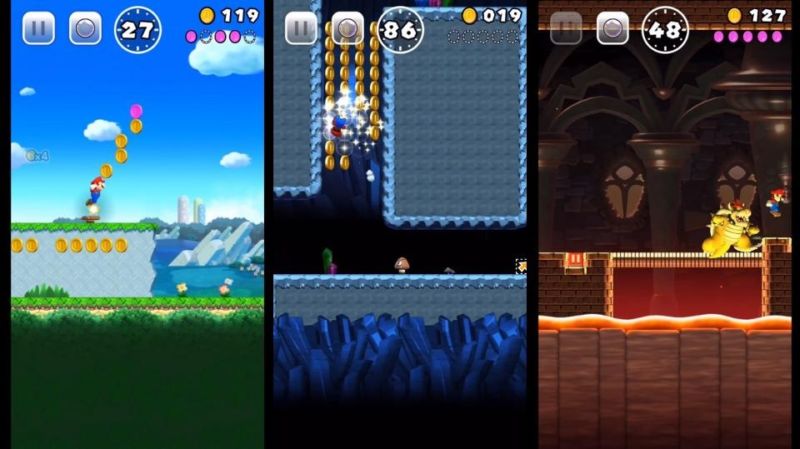
I've dived deep into plenty of games that twist Mario's basic run-and-jump-and-explore formula to the point of near-unrecognizability. After playing a four-level demo of the mobile Super Mario Run at an Apple Store this morning, though, I think I've experienced the weirdest official take on Mario yet.
On the surface, Super Mario Run has all the trappings of a standard 2D Mario game—coins, goombas, koopa troopas, a jumpy mustachioed guy with a red hat and blue overalls. The graphics and sound assets seem to be taken directly from the New Super Mario Bros. series, and it all looks much better on the iPhone's retina screen than it ever did on the limited portable screens of the DS and 3DS.
Everything you see and hear primes your brain to be ready for a somewhat standard experience. Actually playing the game, though, requires a complete rethinking of what you usually do when you see those familiar pieces. The biggest change, obviously, is the inability to move backward at will. As first announced back in September, Super Mario Run automatically pushes Mario forward at a set speed, letting you jump with a tap of the finger. Unlike the never-ending series of randomly created challenges in many "endless runner" games, though, here you're running through a set of human-crafted levels (in the standard "World Tour" mode, at least). In that way, it's more like an "endful runner."For a one-button game where you can't directly control your speed, you can get a surprising amount of fine control out of Mario here. Different tap lengths give different jump heights, of course, but there are also wall jumps, enemy bounces, mid-air spins to extend your distance, and special blocks that allow for long jumps and backflips.
Still, it's difficult to get the precision you might be used to in Mario games that use a d-pad or thumbstick. This is especially noticeable when you try to chain together sequential bounces on enemy's heads (which lead to a coin multiplier for each hop without touching the ground). It's definitely possible, but the inability to control your speed mid-air makes it easy to over or undershoot by just a hair.
Luckily, the game is pretty forgiving, automatically vaulting Mario over small enemies that he would run into fatally in pretty much every other Mario game. In fact, if you tap the jump button just before running into an enemy, you can kill them with a quick bunny hop rather than just avoiding them as you would in previous games.
More than jump precision, though, being pushed constantly forward feels especially limiting to the sense of exploration that's always been integral to Mario games. Playing Super Mario Run, you have to quickly tamp down the usual urge to look everywhere and track down every coin and hidden item. Instead, you're constantly making split-second decisions on whether to stay on the low path or jump for the high path (or sometimes a middle path) with little time to really consider your next move. (There are occasionally blocks that freeze you in place to think about that next decision, but not as often as you might like.)
Sometimes the answer for where to go next is simple. Jump for the cache of coins atop a series of wall jumps rather than running into enemies down below, for instance. Other times, it's not clear on a first playthrough which coin-filled path is the best one to take. In fact, you might not realize until a few seconds later that choosing the upper path means missing a rare pink coin on the lower path or that an important item is now completely inaccessible because of something you chose earlier in the level.
In any case, it feels weird constantly cutting off possibilities with your choice of direction and being literally unable to collect every coin in many situations. This kind of auto-scrolling or path-limiting maze gameplay used to be a rarity in Mario games. In Super Mario Run, it's the standard.
Obviously, the creators want you to replay the short levels over and over again, trying different paths and eventually memorizing the best possible choice at every fork to maximize your coin count (which seems to be the main point). Already, though, I can tell it's going to be frustrating to play through an entire level just to investigate what was in that lone question mark block I missed partway through the last time. The strict, 60-second time limits don't help either, since they make you constantly wonder if spending time in that coin-filled cavern is going to hurt your chances of making it to the goal line.
Perhaps it's a mistake to expect the first Mario game on a button-free mobile platform to capture the same feeling as pretty much all the games that came before it. But despite the weird experiments and gameplay tweaks that Mario has seen in his long history, the sight of those overalls and those familiar question-mark boxes has traditionally implied a certain type of game. A Mario game encourages exploration, precision jumping, deep investigation for secrets, and puzzles that sometimes require slow contemplation.
In Super Mario Run, the world scrolls by too fast for any of that, leaving you with an experience that looks familiar but feels like something utterly different—something much simpler. Playing the rest of the game's 24 levels (and two other modes) next week might change that feeling, but right now, Super Mario Run feels too different for this fan to easily accept.
reader comments
75